COLLECTIONS / Icons and Wood-Carvings
The Museum's Byzantine and Post-Byzantine icons constitute one of its largest and most important collections. The collection stands out not just by the exceptionally large number of works it contains - ca 3,000 - but also by the wide range of iconographies it covers across the chronological spectrum of Byzantine and Post-Byzantine art, which moreover come from all over Greece, Asia Minor, the Balkans and Russia.
There are also 250 diptychs and triptychs in the collection, dating from the 15th to the 19th century. These artefacts were for the most part works of private devotion.
Some woodcarvings, such as three carved wooden sanctuary iconostases from churches in the Ionian Islands and Northern Greece, episcopal thrones, etc. complete the collection.
-
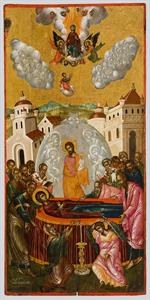 The Dormition and Assumption of the Virgin
The icon depicts the Dormition of the Virgin including the episode of the Iefonias, the Jew who tried to touch her dead body....
The Dormition and Assumption of the Virgin
The icon depicts the Dormition of the Virgin including the episode of the Iefonias, the Jew who tried to touch her dead body.... -
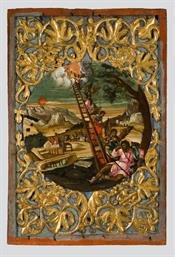 Jacob’s Ladder
Closure panel of an iconostasis from Zakynthos. Painted by the Cretan artist Ilias Moskos. A cottage near a river bridge and ...
Jacob’s Ladder
Closure panel of an iconostasis from Zakynthos. Painted by the Cretan artist Ilias Moskos. A cottage near a river bridge and ... -
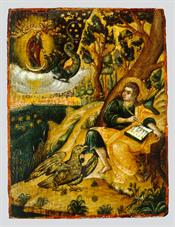 St John the Theologian writing the Book of Revelation
Saint John the Theologian, writing the book of Revelation. In the back the city of Patmos, built by the sea.
St John the Theologian writing the Book of Revelation
Saint John the Theologian, writing the book of Revelation. In the back the city of Patmos, built by the sea. -
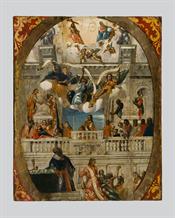 The Liturgy of St Spyridon
Painted by the Lacedaimonian Panagiotis Doxaras. It is a largely unknown till recently sketch of the ceiling decoration of th...
The Liturgy of St Spyridon
Painted by the Lacedaimonian Panagiotis Doxaras. It is a largely unknown till recently sketch of the ceiling decoration of th... -
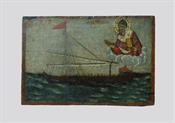 A miracle by Saint Spyridon
At the upper right, the saint appears through clouds to bless, while a galley, with folded sails and a red flag, sails into r...
A miracle by Saint Spyridon
At the upper right, the saint appears through clouds to bless, while a galley, with folded sails and a red flag, sails into r... -
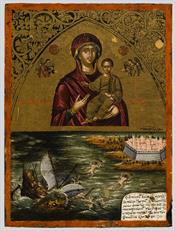 The miracle of the Virgin
We see men fleeing the half-sunk ship, swimming towards the shore. In the inscription we read the story of the shipwreck: the...
The miracle of the Virgin
We see men fleeing the half-sunk ship, swimming towards the shore. In the inscription we read the story of the shipwreck: the... -
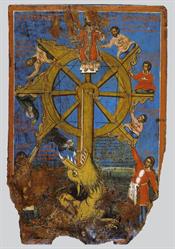 The seven Ages of Man
The scene is allegorical. The theme is the meaning of the time from the birth to the death of every man: at the outer periphe...
The seven Ages of Man
The scene is allegorical. The theme is the meaning of the time from the birth to the death of every man: at the outer periphe... -
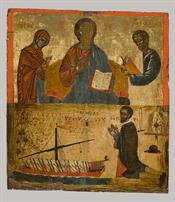 Deesis and votive scene
In the lower zone, left, a sail ship is depicted moored, with sails folded and the oars above water. To the back, the inscrip...
Deesis and votive scene
In the lower zone, left, a sail ship is depicted moored, with sails folded and the oars above water. To the back, the inscrip... -
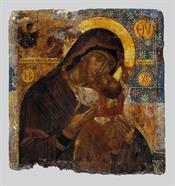 Virgin Glykophilousa
This portable icon depicts the Virgin Glykophilousa-Kardiotissa. According to its stylistic elements, that strongly remind th...
Virgin Glykophilousa
This portable icon depicts the Virgin Glykophilousa-Kardiotissa. According to its stylistic elements, that strongly remind th... -
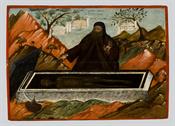 Saint Sisoes facing the tomb of Alexander the Great
Sisoes, a hermit pursuing ascetism in Egypt is visiting the tomb of Alexander the Great. Looking at the dead hero he is medit...
Saint Sisoes facing the tomb of Alexander the Great
Sisoes, a hermit pursuing ascetism in Egypt is visiting the tomb of Alexander the Great. Looking at the dead hero he is medit... -
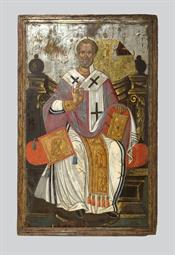 Saint Nicholas
This portable icon depicted Saint Spyridon enthroned. Beneath this scene that is dated in 18th c., an older painting layer wa...
Saint Nicholas
This portable icon depicted Saint Spyridon enthroned. Beneath this scene that is dated in 18th c., an older painting layer wa... -
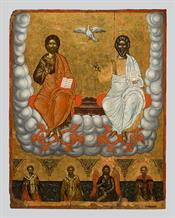 Holy Trinity and Saints
The Holy Trinity with the saints Eleutherios, Athanasios, John the Baptist, and Charalambos. The painter was of Cretan descen...
Holy Trinity and Saints
The Holy Trinity with the saints Eleutherios, Athanasios, John the Baptist, and Charalambos. The painter was of Cretan descen... -
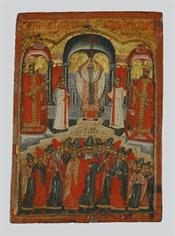 The Elevation of the Holy Cross
The icon shows the scene when the Patriarch of Jerusalem Makarios presented the Holy Cross to the people of this city. The Pa...
The Elevation of the Holy Cross
The icon shows the scene when the Patriarch of Jerusalem Makarios presented the Holy Cross to the people of this city. The Pa... -
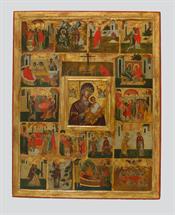 Saint Anna and scenes from the Life of the Virgin.
A walled garden with a fountain, trees and plants. Detail from the prayer of Saint Anna, the mother of the Virgin in a portab...
Saint Anna and scenes from the Life of the Virgin.
A walled garden with a fountain, trees and plants. Detail from the prayer of Saint Anna, the mother of the Virgin in a portab... -
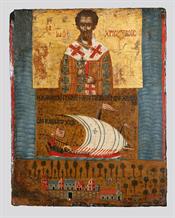 St John Chrysostom, the widow's vineyard, and the transfer of his relic.
In the upper zone, John Chrysostom appears in bust. In the middle zone, a small sailing ship carries the holy relic to Consta...
St John Chrysostom, the widow's vineyard, and the transfer of his relic.
In the upper zone, John Chrysostom appears in bust. In the middle zone, a small sailing ship carries the holy relic to Consta... -
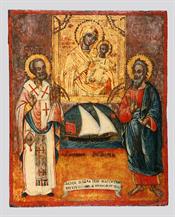 St Nicholas and Andrew flagging the icon of Virgin Hodegetria
In between the saints are depicted the image of Virgin and a ship with two masts with open sails and red flag carrying the em...
St Nicholas and Andrew flagging the icon of Virgin Hodegetria
In between the saints are depicted the image of Virgin and a ship with two masts with open sails and red flag carrying the em... -
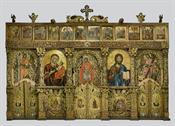 Iconostasis
The parts of the iconostasis, that are dated in the 17th-18th c., have different origins: the wood-curved part is from the Io...
Iconostasis
The parts of the iconostasis, that are dated in the 17th-18th c., have different origins: the wood-curved part is from the Io... -
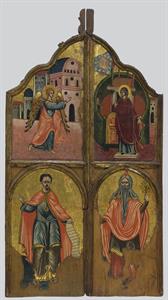 Sanctuary doors with the depiction of the Annunciation, Prophets Moses and Aaron
The newest layer of painting dated in the late 18th century which was removed from the older one dated in the 15th century (B...
Sanctuary doors with the depiction of the Annunciation, Prophets Moses and Aaron
The newest layer of painting dated in the late 18th century which was removed from the older one dated in the 15th century (B... -
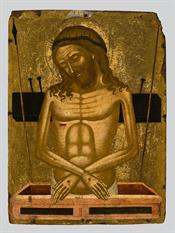 Man of Sorrows
The icon depicts the iconographic type known as the “Man of Sorrows”. The center of the scene is dominated by the figure of t...
Man of Sorrows
The icon depicts the iconographic type known as the “Man of Sorrows”. The center of the scene is dominated by the figure of t... -
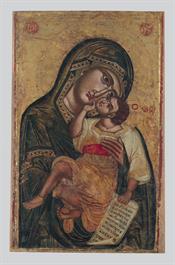 Theotokos Glykophilousa
The painting layer of the 18th century which had been detached from the layer of the 12th century (BXM 984) depicting the Gly...
Theotokos Glykophilousa
The painting layer of the 18th century which had been detached from the layer of the 12th century (BXM 984) depicting the Gly... -
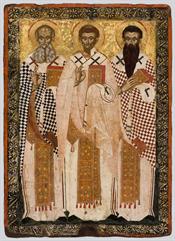 Three Hierarchs
The painting layer of the 18th century which had been detached from the layer of the 14th century (BXM 992) depicting the Thr...
Three Hierarchs
The painting layer of the 18th century which had been detached from the layer of the 14th century (BXM 992) depicting the Thr...
Comments
Users must be registered and logged in to comment.
No comments found.